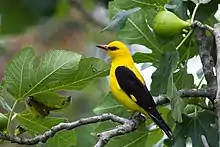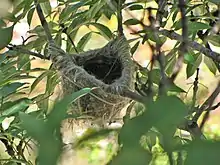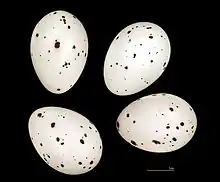Eurasian golden oriole
The Eurasian golden oriole (Oriolus oriolus) or simply golden oriole, is the only member of the Old World oriole family of passerine birds breeding in Northern Hemisphere temperate regions. It is a summer migrant in Europe and western Asia and spends the winter season in central and southern Africa.
| Eurasian golden oriole | |
|---|---|
 | |
| Male | |
 | |
| Female | |
| Scientific classification | |
| Kingdom: | Animalia |
| Phylum: | Chordata |
| Class: | Aves |
| Order: | Passeriformes |
| Family: | Oriolidae |
| Genus: | Oriolus |
| Species: | O. oriolus |
| Binomial name | |
| Oriolus oriolus | |
 | |
| Summer Winter | |
| Synonyms | |
| |
Golden orioles have an extremely large range with large populations that are apparently stable. Therefore, they are evaluated as least concern by BirdLife International.[1]
Taxonomy and systematics
The Eurasian golden oriole was described by the Swedish naturalist Carl Linnaeus in 1758 in the tenth edition of his Systema Naturae and given the binomial name Coracias oriolus.[3] The Eurasian golden oriole and the Indian golden oriole were formerly considered as conspecific, but in 2005 they were treated as separate species by the ornithologists Pamela Rasmussen and John Anderton in the first edition of their Birds of South Asia.[4][5] Support for this split was provided by a molecular phylogenetic study published in 2010,[6] and most ornitholists now treat the Indian golden oriole as a separate species.[7] Alternate names for the Eurasian golden oriole include the European golden oriole and western Eurasian golden oriole. The species is monotypic.[8]
Etymology
The name "oriole" was first used in the 18th century and is an adaptation of the scientific Latin genus name, which is derived from the Classical Latin "aureolus" meaning golden. Various forms of "oriole" have existed in Romance languages since the 12th and 13th centuries.[9] Albertus Magnus used the Latin form oriolus in about 1250 and erroneously stated that it was onomatopoeic because of the golden oriole's song. In medieval England its name, derived from the song, was the woodwele.
Description
The male is striking in the typical oriole black and yellow plumage, but the female is a drabber green bird. Orioles are shy, and even the male is remarkably difficult to see in the dappled yellow and green leaves of the canopy. In flight they look somewhat like a thrush, strong and direct with some shallow dips over longer distances. The New World orioles are similar in appearance to the Oriolidae, but are icterids and unrelated to the Old World birds.
The male of the Indian golden oriole (Oriolus ) has the black eye-stripe extending behind the eye, has a longer and paler red bill and has more yellow in the plumage.[10][11]
Their call is a screech like a jay, but the song is a beautiful fluting weela-wee-ooo or or-iii-ole, unmistakable once heard.
Distribution and habitat
The breeding range of this species spans from western Europe and Scandinavia east to China. They winter in central and southern Africa.[1] They generally migrate during the night, but may travel during the day in the spring migration. During the autumn migration they migrate via the Eastern Mediterranean where they feed on fruit; they are often considered a pest in this region because of this.[12]
The Eurasian golden oriole inhabits a range of habitats. In Western Europe they prefer open broadleaf forests and plantations, copses, riverine forest, orchards, large gardens; in Eastern Europe they may inhabit more continuous forest as well as mixed or coniferous forests. They generally avoid treeless habitats but may forage there. In their wintering habitat they are found in semi-arid to humid woodland, tall forests, riverine forest, woodland/savanna mosaic and savanna.[12]
Behaviour and ecology


Breeding
Eurasian golden orioles may delay breeding until they are 2 or 3 years of age. Males usually arrive at breeding area several days before the females. The fidelity to a territory or even to a specific nest site suggests that the pair-bond may continue from one breeding season to the next.[13] The nest is placed high in a tree towards the edge of the crown. The deep cup-shaped nest is suspended below a horizontal fork of thin branches. It is built by the female, but the male will sometimes gather some of the material. The nest is held in place by plant fibres up to 40 cm (16 in) in length and lined with fine grass, feathers and wool. The clutch is usually between 3 and 5 eggs. These are laid at daily intervals early in the morning. The eggs are on average 30.4 mm × 21.3 mm (1.20 in × 0.84 in) with a calculated weight of 7.3 g (0.26 oz). They can be white, cream or very pale pink and are decorated with black marks which are sometimes concentrated at the larger end. The eggs are mainly incubated by the female but the male will incubate for short periods to allow the female to feed. The eggs hatch after 16–17 days. The young are fed by both parents but are mostly brooded by the female. The young fledge after 16–17 days. The clutch is only rarely lost to predators as the parents vigorously defend their nest.[14]
The greatest recorded age for a Eurasian golden oriole is 10 years and 1 month for a male that was ringed in Lincolnshire in 1986 and seen alive in Cambridgeshire in 1996.[15][16]
Feeding
They feed on insects and fruit, using their bills to pick insects out of crevices.
References
- BirdLife International (2017). "Oriolus oriolus". IUCN Red List of Threatened Species. 2017: e.T103692938A111783061. doi:10.2305/IUCN.UK.2017-1.RLTS.T103692938A111783061.en.
- "Oriolus oriolus (Linnaeus, 1758) - Eurasian Golden Oriole". Natural History Museum. Retrieved 2019-08-07.
- Linnaeus, Carl (1758). Systema Naturae per regna tria naturae, secundum classes, ordines, genera, species, cum characteribus, differentiis, synonymis, locis (in Latin). Volume 1 (10th ed.). Holmiae:Laurentii Salvii. p. 107.
- Rasmussen, Pamela C.; Anderton, John C. (2005). Birds of South Asia. The Ripley Guide. Volume 2. Washington D.C. and Barcelona: Smithsonian National Museum of Natural History and Lynx Edicions. p. 586. ISBN 978-84-87334-66-5.
- Mayr, Ernst; Greenway, James C. Jr, eds. (1962). Check-list of birds of the world. Volume 15. Cambridge, Massachusetts: Museum of Comparative Zoology. p. 127.
- Jønsson, K.A.; Bowie, R.C.K.; Moyle, R.G.; Irestedt, M.; Christidis, L.; Norman, J.A.; Fjeldså, J. (2010). "Phylogeny and biogeography of Oriolidae (Aves: Passeriformes)". Ecography. 33 (2): 232–241. doi:10.1111/j.1600-0587.2010.06167.x.
- Lepage, Denis. "Indian Golden-Oriole Oriolus kundoo Sykes, 1832". Avibase. Retrieved 20 December 2017.
- Gill, Frank; Donsker, David, eds. (2017). "Orioles, drongos & fantails". World Bird List Version 7.3. International Ornithologists' Union. Retrieved 20 November 2017.
- "Oriole". Oxford English Dictionary (Online ed.). Oxford University Press. (Subscription or participating institution membership required.)
- Rasmussen, Pamela C.; Anderton, John C. (2012). Birds of South Asia. The Ripley Guide. Volume 2: Attributes and Status (2nd ed.). Washington D.C.: Smithsonian National Museum of Natural History. p. 586. ISBN 978-84-96553-87-3.
- Walther, B.; Jones, P. (2017). del Hoyo, J.; Elliott, A.; Sargatal, J.; Christie, D.A.; de Juana, E. (eds.). "Indian Golden Oriole (Oriolus kundoo)". Handbook of the Birds of the World Alive. Lynx Edicions. Retrieved 18 December 2017.
- Walther, B.; Jones, P. (2008), "Family Oriolidae (Orioles)", in J., del Hoyo; A., Elliott; D. A., Christie (eds.), Handbook of the Birds of the World. Volume 13: Penduline-tits to Shrikes, Barcelona: Lynx Edicions, pp. 692–723, ISBN 978-84-96553-45-3
- Cramp & Perrins 1993, p. 421.
- Cramp & Perrins 1993, pp. 429-430.
- "Longevity records for Britain & Ireland in 2016". British Trust for Ornithology. Retrieved 20 December 2017.
- "European Longevity Records". Euring. Retrieved 20 December 2017.
Sources
- Cramp, Stanley; Perrins, C.M., eds. (1993). "Oriolus oriolus Golden oriole". Handbook of the Birds of Europe the Middle East and North Africa. The Birds of the Western Palearctic. Volume VII: Flycatchers to Strikes. Oxford: Oxford University Press. pp. 415–433. ISBN 978-0-19-857510-8.
External links
| Wikimedia Commons has media related to Oriolus oriolus. |
| Wikispecies has information related to Oriolus oriolus. |
- Oriolus oriolus in Field Guide: Birds of the World on Flickr
- "Oriolus oriolus". Avibase.

- Ageing and sexing (PDF; 5.3 MB) by Javier Blasco-Zumeta & Gerd-Michael Heinze
- Internet Bird Collection: Golden Oriole videos, photos and sounds
- (European =) Eurasian golden oriole - Species text in The Atlas of Southern African Birds.
- Listen to an oriole singing
- Xeno-canto: audio recordings of the Eurasian golden oriole
